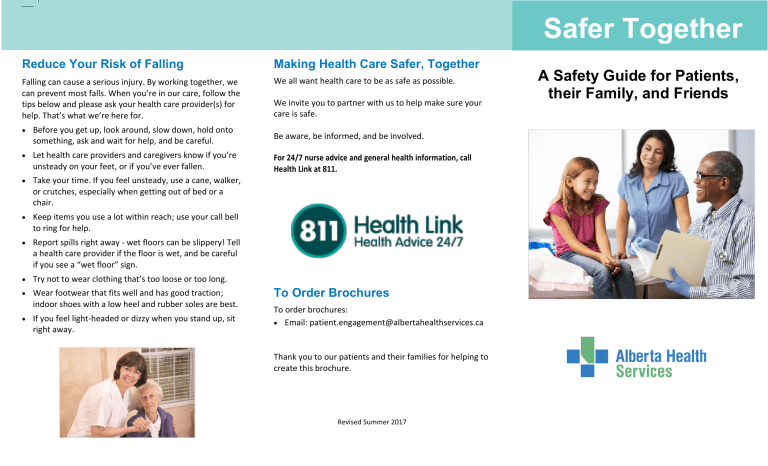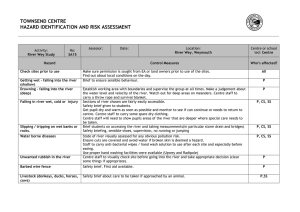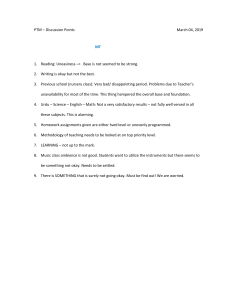
Safer Together Reduce Your Risk of Falling Making Health Care Safer, Together Falling can cause a serious injury. By working together, we can prevent most falls. When you’re in our care, follow the tips below and please ask your health care provider(s) for help. That’s what we’re here for. We all want health care to be as safe as possible. We invite you to partner with us to help make sure your care is safe. Before you get up, look around, slow down, hold onto something, ask and wait for help, and be careful. Be aware, be informed, and be involved. Let health care providers and caregivers know if you’re unsteady on your feet, or if you’ve ever fallen. For 24/7 nurse advice and general health information, call Health Link at 811. Take your time. If you feel unsteady, use a cane, walker, or crutches, especially when getting out of bed or a chair. Keep items you use a lot within reach; use your call bell to ring for help. Report spills right away - wet floors can be slippery! Tell a health care provider if the floor is wet, and be careful if you see a “wet floor” sign. Try not to wear clothing that’s too loose or too long. Wear footwear that fits well and has good traction; indoor shoes with a low heel and rubber soles are best. If you feel light-headed or dizzy when you stand up, sit right away. To Order Brochures To order brochures: Email: patient.engagement@albertahealthservices.ca Thank you to our patients and their families for helping to create this brochure. Revised Summer 2017 A Safety Guide for Patients, their Family, and Friends Alberta Health Services is committed to partnering with you to provide safe, quality care throughout the health care system. Patients and families play an important role in making care safe by being aware, informed, and an active, involved member of their health care team. Verify Your Identity Know Your Medicine Ask. Listen. Talk. We’re here to keep you safe, and good communication is a big part of that. Help us by doing these 3 things: ASK your health care providers about your health care plan. Find out what you can do to feel better and improve your health. LISTEN carefully and ask for more information, especially if you don’t understand. Take notes and bring a friend or family member with you for support. TALK to your health care providers about your concerns, needs, and priorities. Talk about your plan of care, what it means, and what you can expect will happen. Be sure all your health care providers know your entire health history and the first and last name of your family doctor. Tell your health care team if you need a translator. Verifying your identity is an important part of safe, quality health care. For your safety, we check and confirm your identification at different points in your health care journey. This can be at patient registration, before a procedure, or while receiving care. We confirm your identity in a few ways. For example, we may ask you to say your name and birth date, or ask for your health care card or other identifying documents. Please let us know if you change your name, address, phone number, or emergency contact. Clean Your Hands Keeping your hands clean is the best way to prevent spreading infection. Cough or sneeze into your sleeve or cover your mouth and nose with a tissue. Help stop germs by using the alcoholbased hand rub you see throughout the site, or by washing your hands well with soap and water for 20 seconds. When you can see that your hands are dirty, wash with soap and water for 20 seconds. Ask for help if you need to. If you aren’t sure if your health care provider has cleaned their hands before coming into contact with you, it’s okay to ask. Remind others to clean their hands, including your family, friends, or health care providers. If you’re sick, please don’t visit or come to a hospital or care centre until you’re better. You know best what medicine you take and how you take it. Use a MedList to keep an up-to-date list of all the medicine you take and carry it with you. You can also include any allergies you have. Share your MedList every time you see a health care provider. Medicine means more than prescriptions. They’re over-the-counter medicine, supplements, vitamins, herbal remedies, inhalers, patches, ointments, eye drops, and samples your doctor gives you. Include the product name, the dose, and time you take it on your MedList. If a medicine is changed, make sure you know why - it’s okay to ask. Know what your medicine is for and how to take it (e.g., with food). Remember to update your MedList. Have you ever had a reaction to a medicine or a food? If so, make sure your health care team knows. To learn more about MedLists, go to www.ahs.ca/info/Page12614.aspx



